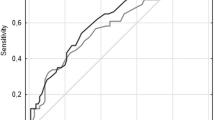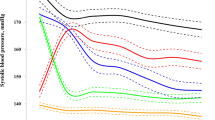Abstract
Manipulation of blood pressure (BP) in acute stroke may improve outcome. Despite various studies, data on the prognostic significance of early BP in stroke remain unclear. Therefore, we studied the relationship between various BP variables in the acute phase of stroke and functional outcome at 3 months. Blood pressures were collected by reviewing BP records of 817 patients who were admitted to our stroke unit between 1987 and 1992. Besides the first systolic and diastolic admission BP (SBP and DBP), we also used the mean of the daytime as well as the night-time systolic and diastolic BP values. Finally, we studied the relationship between the decrease in BP between day 0 and 4 and outcome. As dependent outcome variable we used the Rankin handicap score at 3 months dichotomized in a score >3 (poor outcome) vs a score ⩽3 (good outcome). A total of 430 patients were admitted within 24 h following stroke onset. There was no significant relationship between the systolic and diastolic BP and the outcome at 3 months. Only night-time systolic BP ⩾165 mm Hg (odds ratio (OR) 2.8; 95% CI 1.1–6.8), night-time diastolic BP ⩽60 mm Hg (OR 8.1; 95% CI 1.1–58.3), and a decrease in daytime diastolic BP between day 0 and 4 of ⩾10 mm Hg (OR 3.0; 95% CI 1.1–7.9) showed a significant relationship with poor outcome. Our findings suggest that admission BP values may not reliably reflect any impact of BP on stroke outcome. They also suggest a potential differential effect of BP manipulation: increasing or decreasing BP may be beneficial for patients with BP extremes in one direction, but detrimental for those with BP values in the opposite direction.
This is a preview of subscription content, access via your institution
Access options
Subscribe to this journal
Receive 12 digital issues and online access to articles
$119.00 per year
only $9.92 per issue
Buy this article
- Purchase on Springer Link
- Instant access to full article PDF
Prices may be subject to local taxes which are calculated during checkout


Similar content being viewed by others
References
Chamorro A et al. Blood pressure and functional recovery in acute ischemic stroke Stroke 1998 29: 1850–1853
Feldmann E, Skolnick BE . Cerebral hemodynamics, autoregulation, and blood pressure management J Stroke Cerebrovasc Dis 1999 8: 176–182
Robinson T et al. The predictive role of 24-hour compared to casual blood pressure levels on outcome following acute stroke Cerebrovasc Dis 1997 7: 264–272
Harper G, Castleden CM, Potter JF . Factors affecting changes in blood pressure after acute stroke Stroke 1994 25: 1726–1729
Bath FJ, Bath PMW . What is the correct management of blood pressure in acute stroke? The Blood Pressure in Acute Stroke Collaboration Cerebrovasc Dis 1997 7: 205–213
Carlberg B, Asplund K, Hägg E . The prognostic value of admission blood pressure inpatients with acute stroke Stroke 1993 24: 1372–1375
Adams GF . Prospects forpatients with strokes, with special reference to the hypertensive hemiplegic BMJ 1965 ii: 253–259
Droller H . The outlook in hemiplegia Geriatrics 1965 20: 630–636
Dávalos A et al. Deteriorating ischemic stroke: risk factors and prognosis Neurology 1990 40: 1865–1869
Allen CMC . Predicting the outcome of acute stroke: a prognostic score J Neurol Neuro Surg Psychiatry 1984 47: 475–480
Terayama Y, Tanahashi N, Fukuuchi Y, Gotoh F . Prognostic value of admission blood pressure inpatients with intracerebral hemorrhage Stroke 1997 28: 1185–1188
Hénon H et al. Early predictors of death and disability after acute cerebral ischemic event Stroke 1994 26: 392–398
Yamamoto Y et al. Adverse effect of nighttime blood pressure on the outcome of lacunar infarctpatients Stroke 1998 29: 570–576
Dawson SL et al. Diurnal blood pressure change varies with stroke subtype in the acute phase Stroke 1998 29: 1519–1524
Sander D, Klingelhöfer J . Changes of circadian blood pressure patterns after hemodynamic and thromboembolic brain infarction Stroke 1994 25: 1730–1737
Mansoor GA, White WB . Ambulatory blood pressure monitoring in cerebrovascular and retinal vascular disease J Stroke Cerebrovasc Dis 1997 6: 313–318
Maeda Y et al. Diurnal blood pressure rhythm in hypertensives with parental history of stroke Am J Hypertens 1997 10: 562–564
Elliott WJ . Circadian variation in blood pressure. Implications for the elderlypatient Am J Hypertens 1999 12: 43S–49S
Rankin J . Cerebral vascular accidents inpatients over the age of 60: II. Prognosis Scott Med J 1957 2: 200–215
Sulter G, Steen C, De Keyser J . Use of the Barthel Index and Modified Rankin Scale in acute stroke trials Stroke 1999 30: 1538–1541
Allen CMC . Clinical diagnosis of the acute stroke syndrome Quart J Med, New Series LII 1983 208: 515–523
Bamford J, Sandercock P, Jones L, Warlow C . The natural history of lacunar infarction: The Oxfordshire Community Stroke Project Stroke 1987 18: 545–551
Chau NP et al. Relationships between cardiac output, heart rate and blood volume in essential hypertension Clin Science Mol Med 1978 54: 175–180
Wallace JD, Levy LL . Blood pressure after stroke JAMA 1981 246: 2177–2180
Powers WJ . Acute hypertension after stroke: the scientific basis for treatment decisions Neurology 1993 43: 461–467
Britton M, Carlsson A . Very high blood pressure in acute stroke J Int Med 1990 228: 611–615
Shimada K et al. Diurnal blood pressure variations and silent cerebrovascular damage in elderlypatients with hypertension J Hypertens 1992 10: 875–878
Lip GYH, Gibbs CR, Beevers DG . Ambulatory blood pressure monitoring and stroke: more questions than answers Stroke 1998 29: 1495–1497
Kukla C et al. Changes of circadian blood pressure patterns are associated with the occurrence of lacunar infarction Arch Neurol 1998 55: 683–688
Lip GYH et al. Ambulatory blood pressure monitoring in acute stroke: The West Birmingham Stroke Project Stroke 1997 28: 31–35
Jørgensen HS, Nakayama H, Olsen TS . Treatment of arterial hypertension in acute stroke. In: Castillo J, Dávalos A, Toni D (eds) Management of Acute Ischemic Stroke Springer-Verlag, Iberica: Barcelona 1997 81–87
Baron JC . Perfusion thresholds in human cerebral ischemia: historical perspective and therapeutic implications Cerebrovasc Dis 2001 11 (Suppl): 2–8
Furlan M et al. Spontaneous neurological recovery after stroke and the fate of the ischemic penumbra Ann Neurol 1996 40: 216–226
Marchal G et al. Prolonged persistence of substantial volumes of potentially viable brain tissue after stroke. A correlative PET-CT study with voxel-based data analysis Stroke 1996 27: 599–606
Marchal G et al. Voxel-based mapping of irreversible ischaemic damage with PET in acute stroke Brain 1999 122: 2387–2400
Author information
Authors and Affiliations
Corresponding author
Rights and permissions
About this article
Cite this article
Boreas, A., Lodder, J., Kessels, F. et al. Prognostic value of blood pressure in acute stroke. J Hum Hypertens 16, 111–116 (2002). https://doi.org/10.1038/sj.jhh.1001304
Received:
Revised:
Accepted:
Published:
Issue Date:
DOI: https://doi.org/10.1038/sj.jhh.1001304



